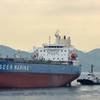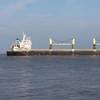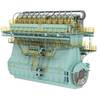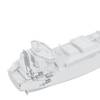The ABB Electric Tow Boat Beckons to Inland Operators
Long a staple for offshore service providers, a more compact and carefully designed version of the diesel electric option is now available for inland pushboats. For budget conscious operators (and who isn’t, in this environment?), the stars may finally be aligned.
For many years, electric propulsion has proven to be a viable propulsion solution for many different types of vessels. Most familiar to workboat stakeholders would be the advent of the ‘diesel electric’ offshore serve providers (OSV) that became commonplace during the offshore boom era. Those vessels operated in a different regulatory environment, with the emphasis more leaning towards operational efficiencies and fuel economy. Those benchmarks are still important, of course, but today’s EPA’s rapidly escalating Tier standards for marine engines bring new pressures and many variables into mix.
Those offshore systems were, by and large, too big to fit into a conventional inland pushboat, hence the concept never had legs for inland commerce. Until now. ABB’s electric propulsion systems are now available to help long-established towboat owners operating chiefly on U.S. inland waterways to solve some very modern challenges. In a nutshell, diesel electric propulsion offers owners a way to build compliant vessels operating on easier to meet Tier 3 main engines. That doesn’t mean that these won’t be efficient and environmentally friendly systems. They will.
The waterfront in general has never been known to be an early adopter of most readily available technologies, but experience shows that domestic inland owners will commit to new technologies when it makes business sense. Sometimes, new regulations can have way of speeding up that process. Indeed, the new rules have major cost implications for owners looking to build new vessels, concurrent with the reality of an aging river fleet at a time of poor freight rates.
Edward Schwarz, ABB Vice President of New Build Sales, has his own take on what is transpiring today. “The US inland river vessel owners were known as pioneers around the world with regard to introducing the consistent use of steam vessels thus helping usher in the 1st industrial revolution,” he says, and then asks, “Then why does the perception exist that the US inland river industry is an anti-technology group [?]; maybe because they do not appreciate technology solely for technology’s sake. Prior to every major adoption of technology in the US inland river market there is a perfect alignment of opportunity and solution. We are at one of these points today and ABB is ready to help the US inland market enjoy the benefits of the 4th industrial revolution which is based on electrification, digitalization and connectivity.”
The ‘conventional’ option involves installing two large EPA Tier 4 main engines supplemented by an aftertreatment system – either the Exhaust Gas Recirculation (EGR) or Selective Catalyst Reduction (SCR) option. The latter choice can add additional piping, a refill and urea storage tank and demand separate maintenance all within the confines of an already cramped machinery space. With no guarantee that such expenses and arrangements can bring higher rates to support them, the time may well be right for the electric solution to get a second look.
Diesel electric systems use multiple generators to provide power for the propulsion plant via electric motors. Where diesel electric propulsion is chosen, however, EPA Tier 4 emissions requirements can be met using a solution that includes multiple EPA Tier 3 generator sets, with no prospect in sight of the need for costly upgrades.
- Baseline
At its lowest common denominator, the ABB electric propulsion solution is a ‘tier beater.’ That’s not to say it isn’t the right thing to do for today’s responsible and compliant operator. It is. And, it is good design. To that end, diesel electric cut its teeth in the offshore markets, a sector where it found great success. But, in its infancy it was too large for the towboat world. And, it was also expensive. Today’s ABB version is now smaller, more price competitive and designed for the inland towboat. And because it isn’t necessary ‘position dependent’ on the shafts, the logistics of putting it in the limited available machinery space is a bit easier.
Using the latest iteration of this concept, with a smaller ABB packaged generator, a towboat operator would be, at times, able to use one main engine, instead of two, along with the genset. As a result, main engines experience less run time, operating at ideal RPM’s, all adding up to less wear and tear on the engines, and of course, longer intervals between required service. The automated nature of the system can even time all engine service intervals to coincide, resulting in less downtime and more available running time for the towboat to accomplish what it is intended to do: make money.
Quite simply, the system consumes electricity as it produces it, consuming less fuel, and thereby producing a smaller environmental signature. The system – driven by ABB automation technology – decides how much power is needed. Hence, and for larger operators, the likelihood that one Captain or another will be labeled the ‘fleet gas hog’ can be eliminated. That’s because, depending on engine loading characteristics, the ETB configuration can also switch from low load to full load more quickly, in a performance gain that will be discernible to the captain. For its part, ABB claims as much as a 30 percent fuel savings.
- Nuts & Bolts
Cheaper to build than a tier 4 system, and is less expensive to operate (OpEx) than a Tier 3 inland towboat system built just two years ago, the ABB electric towboat package is, for the most part, OEM agnostic. ABB acts as the system integrator, facilitating and allowing smooth interface with and between any and all marine engines, transmissions and gearboxes. If you have a favorite – CAT, Cummins, Scania, Twin Disc, Schottel, ZF, or Steerprop (you name it) – an electric propulsion system can be designed to marry those components.
ABB’s Electric Tow Boat (ETB) addresses new regulations, increasing CAPEX costs for new builds, the imperative for lower OPEX costs and demand for greater vessel reliability. Delivered as a customized system for each towboat, the advent of inland ETB potentially represents the next generation of towboat for the US inland waterway network.
In a recently published analysis, Clarkson Research stated that, “By optimizing the loading of the engines, diesel-electric systems can lower fuel consumption and emissions.” But, owners of cruise ships, tankers, gas carriers, container ships, offshore vessels and tug boats, many operating in the harshest conditions in the world, have chosen diesel electric propulsion over its mechanical equivalent for its greater efficiency, flexibility and reliability.
Joshua Sebastian, Engineering Manager at The Shearer Group, Inc. (TSGI), was more to the point, telling MarineNews, “We believe that the technology behind diesel electric propulsion has finally matured to the point it is now a competitive option for consideration for the inland market. We feel that it is vital to the successful implementation of this technology to partner with companies like ABB that have a proven record with diesel electric combined with domestic service, combined with domestic support facilities.”
For its part, ABB has already supplied over 1,300 vessels featuring diesel electric propulsion. As many as 4,000 towboats operating along the rivers of the United States, annually hauling 25,000 barges and carrying 630 million tons of cargo along 25,000 miles of waterway, await the same benefits.
In simple terms, diesel electric systems draw on variable frequency drives to deliver their efficiency across a broader operating profile, throughout the engine’s total operational cycle. That translates into measurable advantages for those inland operators willing to make the movement to a cleaner environmental signature and a more efficient operation:
- Fuel savings: Often, the charterer pays for fuel. A fuel efficient boat is a more attractive boat.
- Redundancy: The diesel electric solution allows power to be distributed to either propulsion motor, meaning that the impact of a prime mover failure is minimized.
- Flexibility: The vessel can be designed as both a Z-Drive and conventional propeller vessel.
- Safety: In the ABB ETB design, the system can be configured so that a single engine failure can lead to only a 25% reduction in available power, with this loss having no effect on steering or complete loss of propulsion.
- Crew comfort: Keep your crew happier with lower noise levels & vibration through the use of smaller engines.
- Operating profiles: The ABB ETB towboat system exploits variable frequency drives to optimize power use over a wide span of operations: when in standby or moving empty barges, for example.
- Research: ABB has been fine tuning its diesel electric technology for application to a towboat design, basing its work on a study of real river operations undertaken over a 365-day period covering 500 push boat vessels.
- Maintenance/Vessel Availability: Standardized and proven products supported by local Houston-based ABB service teams ensure those on board adapt seamlessly to diesel electric operations.
- Training: ABB’s Marine Academy trains operators to become more proactive in operating and maintaining equipment to maximize availability minimize less downtime.
- Autonomy: the modern towboat does not operate with an electrician onboard, so equipment is robust, requiring very little onboard interaction.
- Connectivity: ABB has almost 1,000 vessels whose equipment is connected to Collaborative Operations Centers, monitoring 24/7 from centers, one right here in the USA.
- Predictive Maintenance: ABB power and control systems support Remote Diagnostic System and Condition-based Monitoring, making it easier to comply with SubM & reduce engine maintenance requirements/costs.
- In the Shipyards: ABB’s standard scope of supply includes all generators, power distribution, automation control and electrical power consumers – ensuring just one vendor for main electrical systems.
- Warranty: ABB offers some of the most extensive and inclusive standard warranties in the marine industry.
- Flexibility: Can be used for both thruster (L-drives) and conventional designed vessels
- Lower OpEx & CapEx: Cheaper to build, more economical to run, less expensive to maintain.
- Not Coming: Already Here
Primarily known for its efficacy in the offshore energy world where DP operations required precise and constant position keeping, punctuated by brief intervals of heavy support service, the diesel electric model is nothing new. But, that’s not to say it hasn’t seen service for the past eight years – in tough conditions – on South American rivers with an RAL fit-for-purpose designed boat employing Schottel drives.
Lawren Best, Robert Allan’s Supervisor of Design Development, told MarineNews in June, “When built these were the most powerful triple z-drive shallow draft push boats in the world. This propulsion system is diesel-electric, with three independent Wartsila 9l20 medium speed diesel gensets each developing 1,710 ekW. AC current propulsion motors and electric drive components from ABB power Schottel SRP 1215 azimuthing drives produce a Bollard Pull of 69 tonnes ahead and 63 tonnes astern. For this project diesel electric propulsion provided advantages of flexibility in positioning the engines and drives to ensure best operating trim in the extremely shallow waters as well as increased propulsion system responsiveness from the medium speed engines when maneuvering.”
To date, the ABB ETB propulsion solution can’t yet claim any domestic inland installations. It may, however, just be a matter of time. It is a fact that inland towboats and barges represent 85 percent of U.S. vessels and it is no small matter that towboats are the oldest with 66 percent older than 25 years. Hence, the current strategy of growing (or maintaining) a fleet not by newbuild but by acquisition of existing assets will not be viable into the foreseeable future. When that time comes, the ABB ETB will be there to fill the void.
This article first appeared in the July 2018 print edition of MarineNews magazine.













